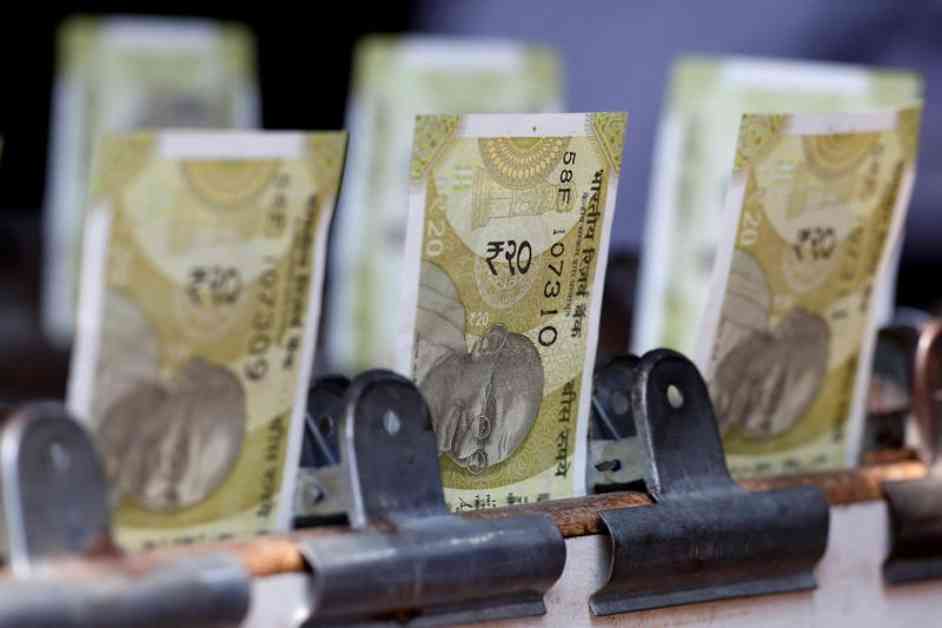The Indian rupee closed almost unchanged on Tuesday, with the central bank’s intervention preventing a fall towards the key psychological support level of 84 against the dollar. The rupee ended at 83.97, nearly flat compared to its historic low of 83.9725 in the previous session. Throughout the day, the currency hovered near its all-time low, with the Reserve Bank of India likely selling dollars through public banks around the 83.97 levels to support the local currency, according to traders. The RBI’s efforts to prevent further depreciation should keep the range of 83.90-83.97 in the short term, at least until the release of US consumer inflation data, as stated by a trader from a foreign bank. The US is set to unveil retail inflation data on Wednesday, with Indian financial markets closed on Thursday.
Market Movements
The dollar index rose by 0.1% to 103.2, while most Asian currencies strengthened, with the Indonesian rupiah gaining 0.7% and leading the pack. Concerns over the slowdown in the US economy and the unwinding of carry trades sparked volatility in global markets last week, which has since subsided. The likelihood of the Federal Reserve cutting rates by 25 basis points or 50 basis points in September was also debated. ING Bank noted, « We continue to expect a soft landing in the US and a mild recovery in Europe and Asia. For foreign exchange markets, this should translate into a gradual weakening of the dollar compared to the disorderly adjustment seen in recent weeks. »
Forward Premiums and Yields
Forward premiums on the dollar-rupee pair have increased, with the one-year implied yield rising by 2 basis points to 2.04%. The market dynamics reflect the cautious stance towards currency movements in the face of global economic uncertainties and central bank actions. The uptick in forward premiums indicates a hedging strategy by market participants to manage potential risks associated with currency fluctuations.
The stability of the Indian rupee above the 84 mark against the US dollar underscores the central bank’s commitment to maintaining exchange rate stability amidst external headwinds. The RBI’s proactive measures to intervene in the currency markets have helped cushion the rupee from sharp declines and maintain investor confidence in the domestic economy. As global economic conditions remain uncertain, the resilience of the Indian rupee reflects a cautious optimism among market participants regarding the country’s economic prospects.
Impact of Global Factors
The recent volatility in global markets, driven by concerns over the US economy and trade tensions, has had a ripple effect on emerging market currencies, including the Indian rupee. The interplay between macroeconomic indicators, geopolitical developments, and monetary policy decisions in major economies has influenced currency movements and investor sentiment. As central banks navigate the challenging economic landscape, market participants are closely monitoring policy announcements and data releases for insights into future trends.
The divergent monetary policies of major central banks, such as the Federal Reserve and the European Central Bank, have created a dynamic environment for currency markets. The potential for policy divergence, coupled with geopolitical risks and trade uncertainties, has added to market volatility and impacted exchange rates. In this context, the Indian rupee’s resilience against the dollar reflects a combination of domestic policy measures and global economic trends shaping currency dynamics.
Outlook and Analysis
Looking ahead, the outlook for the Indian rupee will be influenced by a confluence of domestic and international factors. The central bank’s policy stance, inflationary pressures, global economic conditions, and geopolitical developments will play a crucial role in determining the rupee’s trajectory. As market participants navigate evolving uncertainties, maintaining a balanced approach to risk management and strategic positioning will be essential to navigating currency fluctuations.
In conclusion, the Indian rupee’s ability to hold its ground above the 84 level against the US dollar highlights the resilience of the currency amid global economic challenges. The central bank’s interventions and market dynamics have contributed to stabilizing the rupee and instilling confidence in investors. As the global economic landscape continues to evolve, maintaining a proactive approach to currency management and monitoring key indicators will be key to navigating uncertainties and seizing opportunities in the foreign exchange market.

